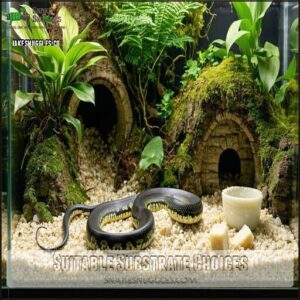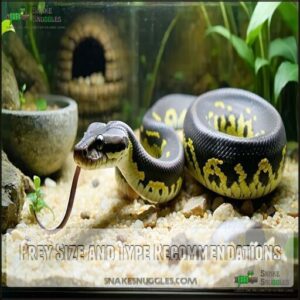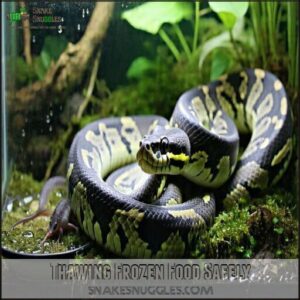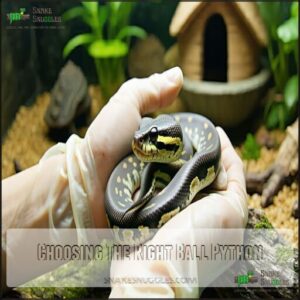This site is supported by our readers. We may earn a commission, at no cost to you, if you purchase through links.

They’re like the golden retrievers of the snake world—docile, manageable, and rarely bite. You’ll appreciate their modest size (3-5 feet) and 20-30 year lifespan, making them long-term companions that won’t outgrow their welcome.
They don’t require daily attention, eating just once every 1-2 weeks. While they need specific temperature and humidity conditions, their care isn’t complicated once you’ve got the setup right.
Just remember that these nighttime explorers might stay hidden during the day—their mysterious nature is part of what makes them fascinating terrarium residents, and they can be considered long-term companions.
Table Of Contents
- Key Takeaways
- Ball Python Pet Suitability
- Are Ball Pythons Good Pets
- Ball Python Characteristics
- Housing and Environmental Needs
- Dietary Needs and Feeding
- Health Concerns and Handling
- Choosing The Right Ball Python
- Frequently Asked Questions (FAQs)
- Is a ball python a good pet?
- Are ball pythons easy to care for?
- Are ball pythons a pet snake?
- Should you buy a ball python?
- Are ball pythons beginner friendly?
- Do ball pythons need a vet?
- Do ball pythons like to be petted?
- Are ball pythons good pets?
- Do ball pythons need a veterinarian?
- What are the cons of owning a ball python?
- Conclusion
Key Takeaways
- You’ll find ball pythons are ideal for beginners due to their docile temperament, manageable size (3-5 feet), and minimal handling requirements—they’re often called the "golden retrievers" of the snake world.
- Your ball python will need specific environmental conditions including a secure enclosure with temperature gradients (75-92°F) and proper humidity (50-60%), but setup becomes low-maintenance once established.
- You won’t need to feed your ball python daily—they only eat every 1-2 weeks, making them less demanding than traditional pets while still providing long-term companionship (20-30 year lifespan).
- You should choose captive-bred specimens over wild-caught for better health, easier feeding habits, and more predictable temperaments, though they’ll still need occasional reptile vet checkups.
Ball Python Pet Suitability
If you’re looking for a calm, manageable pet, ball pythons might be a great choice.
They’re low-maintenance and easy to handle, but they do require proper care and attention to thrive.
Temperament and Handling
Handling a ball python is all about patience and technique. These docile snakes are calm by nature, making them great for beginners.
They may coil into a ball when nervous—don’t worry, it’s just their way of saying, "Give me a moment."
Here are some snake handling tips to guarantee a stress-free experience:
- Handle gently for 5–15 minutes, 2–3 times a week.
- Always support their body; dangling can stress them out.
- Wait 48 hours after feeding to prevent messy surprises.
- Don’t force interaction—they’ll warm up with time.
With consistent gentle handling, your taming process will create a confident, comfortable snake companion.
Space and Housing Needs
Creating the perfect ball python habitat starts with the right snake enclosure size.
Creating the perfect ball python home isn’t just nice—it’s essential for your snake’s health and happiness!
Juveniles are happy in 20-gallon tanks, while adults need 30-40 gallons—enough to stretch out and explore.
Tank security is critical because these snakes are escape artists.
Use escape-proof lids with secure clamps to keep them safe.
For substrate options, choose snake-friendly materials like cypress mulch or coconut husk.
These help with humidity control—ideal levels are 50-60%.
Poor humidity can lead to shedding issues, so don’t skimp here!
Ventilation systems guarantee airflow without drying the environment.
A healthy snake cage balances natural conditions with practical pet snake space needs, preventing stress and health problems.
Feeding and Dietary Requirements
Feeding your ball python isn’t complicated, but it’s all about smart prey selection and consistent feeding schedules.
Juveniles thrive on fuzzy mice every 5-7 days, while adults prefer rats every 10-14 days.
Use tongs to offer prekilled prey, ensuring safety and mimicking natural movement.
Fresh water is essential, so don’t forget to refill!
Thoughtful meal planning keeps your python healthy—because no one wants a hangry snake slithering around!
Health and Veterinary Care
Taking care of your ball python’s health isn’t a daily chore, but it’s smart to schedule regular vet visits. Annual health checks are vital for spotting snake health issues like respiratory infections or snake parasites before they escalate. Early action can save your python from serious health problems.
Find a reptile vet ahead of time so you’re prepared for emergencies. This guarantees that if symptoms like unusual behavior or labored breathing pop up, help is just a call away.
Disease prevention starts with good enclosure care. Keep the temperature and humidity in check to reduce python health problems.
- Pro tip: Clean the enclosure often, as a clean space makes for a healthier, happier snake and minimizes snake health issues. Understanding ball python care is essential for maintaining a healthy environment.
Are Ball Pythons Good Pets
Ball pythons can make excellent pets if you’re prepared for their specific needs.
Their calm nature, manageable size, and long lifespan make them a popular choice, but they require a solid commitment to care.
Pros and Cons of Ownership
Thinking about ball pythons as pets? Here’s the scoop on their pros and cons:
- Calm Nature: Ball pythons rarely bite, and their gentle snake behavior makes them beginner-friendly.
- Low Pet Costs: After an initial $300-500 setup, their monthly expenses are easier on your budget compared to dogs or cats.
- Longevity Concerns: These reptiles live 20-30 years, so owning a python is a big commitment—not ideal for short-term planners.
- Care Challenges: With specific temperature needs and feeding quirks, their pet snake care requires some effort but isn’t overwhelming.
Being well-prepared guarantees smooth ownership!
Comparison to Other Pets
Ball pythons as pets stand out compared to dogs or cats due to their low maintenance and minimal space needs.
Unlike pets that demand daily walks or intricate grooming, their care includes weekly feeding habits and occasional enclosure cleaning.
They’re perfect for apartments, especially if you’re not keen on constant noise or mess, plus, they’re hypoallergenic, so no sneezing fits around these docile companions.
If you’ve got a busy owner lifestyle, they don’t mind some alone time, while cats might scratch furniture and dogs need training, ball pythons simply curl up in their cozy spaces.
Pet costs are affordable—no fancy toys or treats required, it’s truly pet snake care made simple.
Long-Term Commitment Requirements
Owning a ball python means committing to a long-lived companion with a lifespan of 20-30 years.
It’s not just a pet—it’s a lifetime responsibility. Here’s what ongoing care looks like:
- Spend $30-50 per month on food and supplies.
- Budget $100-200 annually for vet visits.
- Plan for heating equipment and enclosure upkeep.
- Arrange care during vacations or unexpected events.
- Factor in time investment for handling and bonding.
Snake ownership commitment pays off with fascinating, low-maintenance companionship for decades!
Ball Python Characteristics
Ball pythons are known for their calm temperament, manageable size, and unique ability to curl into a ball when stressed.
They’re easy to care for and can live decades, making them a favorite among snake enthusiasts.
Physical Characteristics and Lifespan
It’s hard not to admire the unique beauty and fascinating traits of a ball python.
These pet snakes boast incredible Growth Patterns and stunning Color Morphs, ranging from classic black and brown patterns to rare options like albinos and piebalds, reflecting years of selective breeding.
Their muscular Body Structure plays an important role in their constricting hunting style, while their compact heads and smooth scales give them a polished appearance.
Ball pythons are named for their charming defensive behavior—curling into a ball when stressed—which adds to their quirky appeal.
A ball python’s size stabilizes by age three, with adults reaching 4-5 feet long—perfect for handling and housing.
Their lifespan is equally impressive, often ranging from 20 to 30 years in captivity.
With proper care, though, these slithering companions might surprise you by sticking around for half a century or more!
- **Admire their regal, intricate patterns.
- **Marvel at their long lifespans.
- **Embrace their friendly, non-threatening nature.
Size and Weight Expectations
Regarding ball python size, you’ll be pleased to know they don’t require much room.
Adult size typically ranges from 4-5 feet in length, making them an ideal pet snake for smaller homes or apartments.
Females tend to grow larger, hitting the higher end of the length expectations and weighing about 5-6 pounds, while males stay closer to 3-5 pounds.
Growth rates are steady, with most reaching their full adult size within three years.
Their small size and manageable weight limits make caring for a ball python straightforward, and these size variations are perfect for beginners or anyone seeking a low-maintenance, compact pet snake!
Scientific Classification and Origin
If you’re fascinated by python genetics and species history, the ball python (scientifically known as Python regius) is a remarkable reptile with deep evolutionary roots.
Native to the grasslands and savannas of West and Central Africa, these small but mighty constrictors have adapted to coexist with humans for centuries. Their scientific name, “regius,” translates to “royal,” stemming from legends of African royalty wearing them as living jewelry—a fact that’s both fascinating and oddly charming for modern pet snake enthusiasts.
As members of the Pythonidae family, ball pythons are non-venomous and uniquely manageable among snake species. Their evolution in regions like Ghana and Togo shaped key traits that make them resilient and adaptable as reptile pets.
Here’s why their evolutionary traits appeal to python pet ownership:
- Small, easy-to-handle size
- Resilient to captivity
- Peaceful temperament
- Distinct behaviors rooted in their savanna origins
- Connection to centuries-old human culture
Their unique characteristics, including being small and having a distinct behavior, make them appealing pets for many.
Housing and Environmental Needs
Your ball python’s enclosure isn’t just a tank—it’s their entire world, so it needs to mimic their natural habitat.
By providing the right space, temperature, and hiding spots, you’ll keep your snake comfortable, secure, and healthy.
Secure and Spacious Enclosure Recommendations
Creating the perfect home for your ball python isn’t just about space—it’s about providing a secure and comfortable environment.
A 4’x2’x2′ enclosure is ideal, offering enough room for natural behaviors while meeting snake tank requirements.
Since ball pythons are escape artists, make sure the top is escape-proof with secure latches.
Ventilation systems are essential, ensuring fresh airflow while balancing snake temperature and humidity.
Habitat design should also include at least two hiding spots—one on the warm side and one on the cooler side—to help your python feel safe.
Lay down 2-3 inches of substrate, like aspen or bark, to mimic natural surroundings.
Every edge should be checked for gaps to prevent escapes.
With a thoughtful snake enclosure setup, you’ll create a safe haven your python can thrive in.
Proper ball python enclosures design is vital for maintaining the health and well-being of your pet.
Temperature Gradient Requirements
After setting up your ball python’s enclosure, it’s time to focus on temperature. Snakes rely on you for heat—they can’t adjust their own thermostat! Proper thermal gradients mimic their natural environment and keep them healthy.
Your snake’s new home should have three zones:
- Warm side (82-85°F): Helps digestion and keeps your python active.
- Cool side (75-80°F): Allows for temperature regulation and rest.
- Basking spot (88-92°F): Supports metabolism and overall function.
Daily monitoring is key. Place digital thermometers on both ends of the tank for accurate temperature control. Without proper gradients, your snake might struggle with digestion or immunity.
Understanding temperature gradients is essential for creating a suitable environment. Think of this setup as their personal spa—it’s cozy when it’s warm and invigorating on the cool side. Happy snake, happy life!
Heating Options and Humidity Control
Keeping your ball python’s habitat warm and slightly humid is the secret to its happiness and health.
For heating, start with reliable options like heat lamps, heat mats, or ceramic heaters. Each comes with benefits and trade-offs:
| Heat Option | Best For | Pros | Cons |
|---|---|---|---|
| Heat Mats | Small enclosures | Energy-efficient, easy to hide | Limited to one area |
| Ceramic Heaters | Larger tanks | No light, long-lasting | Needs deep fixtures |
| Radiant Panels | Custom setups | Even heat | Expensive upfront |
| Heat Lamps | Budget setups | Affordable, easy install | May dry the enclosure |
Pair any heating element with thermostat controls—this prevents burns and guarantees steady temperatures.
Humidity levels of 50-60% are ideal. Use ventilation systems, a large water dish, or mist occasionally to fine-tune reptile humidity.
When selecting heat sources, consider heat mat options to maintain ideal temperatures. Keep the gradient cozy and humid, and your snake will thrive.
Suitable Substrate Choices
Choosing the right snake substrate for your ball python’s enclosure is a big deal—it impacts moisture levels, humidity control, and overall comfort.
The right bedding material also simplifies snake maintenance and promotes reptile care effectively.
Here are five great substrate options:
- Coconut Fiber – Excellent for humidity control, it mimics tropical habitats your snake may love.
- Reptile Carpet – A reusable tank liner, easy to clean and manage.
- Cypress Mulch – Natural bedding material with good odor control and burrowing texture.
- Paper Towels – Affordable and perfect for monitoring health.
- Sphagnum Moss – Adds moisture pockets for shedding phases and dryness prevention.
Dietary Needs and Feeding
Feeding your ball python isn’t complicated, but it does require some planning.
Understanding their specific diet of mice or rats and sticking to a proper schedule will keep them healthy and happy.
Juvenile and Adult Feeding Schedules
Your ball python’s feeding frequency depends on its growth stage.
Hatchlings eat every 5-7 days, while juveniles need meals every 7-10 days.
Sub-adults can go 10-14 days between meals, and adults often thrive on feedings every 14-21 days.
Pick prey that’s about 10% of their body weight to match their dietary needs.
Feeding your snake on a consistent schedule helps digestion and keeps the snake healthy.
Consider purchasing appropriate python food for ideal health.
Keep an eye on refusals—sometimes they just aren’t hungry or need proper hydration.
Prey Size and Type Recommendations
Feeding your ball python correctly means choosing prey that matches its size and age.
Your snake’s meal shouldn’t be wider than its midsection—this guarantees proper digestion. Hatchlings start with hopper mice, while adults need small to medium rats.
Rotate prey occasionally, like gerbils or small birds, to meet their nutritional needs. Stick to gradual size increases as your python grows.
- Key Tips:
- Match prey size to your python’s girth.
- Use age-appropriate rodents.
- Rotate prey for variety.
- Adjust size gradually.
- Avoid oversized meals.
Frozen-Thawed Rodents Vs Live Prey
Live prey might seem natural, but frozen-thawed rodents are safer and more convenient.
They eliminate prey safety risks since live rodents can injure your snake. Plus, storing frozen meals cuts costs and simplifies snake feeding schedules.
It’s also kinder—no ethical concerns about live feeding. A happy, well-fed snake and an affordable feeding plan? That’s a win-win for everyone!
Frozen rodents also reduce the risk of disease and parasites, which is a significant concern for snake owners.
Thawing Frozen Food Safely
While frozen rodents offer safety advantages over live prey, proper thawing is just as important for your snake’s health.
Safe thawing prevents bacteria growth and preserves nutrients in your ball python’s food.
Here’s how to do it right:
- Never refreeze prey that’s been thawed – this creates dangerous bacteria levels
- Thaw in the refrigerator (8-12 hours) or sealed in cold water (1-2 hours) for best safety
- Always check the core temperature by feeling the prey’s abdomen – it should be room temperature, not cold
- Let prey warm to room temperature for 15-30 minutes before feeding
You wouldn’t eat a half-frozen dinner, and your snake shouldn’t either. Proper thawing methods guarantee your python gets a safe, appetizing meal.
Health Concerns and Handling
You’ll need to check your ball python regularly for health issues like mouth rot or respiratory problems.
Your snake will stay healthier with proper handling techniques that minimize stress, just like how you’d feel cranky if someone picked you up the wrong way, while handling them gently to build trust.
Regular Checkups and Veterinary Care
In the case of your ball python’s health, finding the right veterinarian is like having a good insurance policy.
Regular checkups with a specialized reptile veterinarian help prevent serious python health issues before they develop.
- Most common snake diseases are easier and cheaper to treat when caught early
- Quarantine protocols for new pythons should be discussed with your vet
- Cost factors vary widely, so budget $100-300 annually for preventative care
Unlike dogs or cats, snake veterinary visits are typically less frequent, but no less important.
Don’t wait for symptoms to appear!
Many reptile veterinarians book months in advance, so establish a relationship early.
Remember, your scaly friend can’t tell you when they’re feeling unwell, and regular checkups can help prevent serious python health issues before they develop, which is why it’s crucial to budget for preventative care and consider quarantine protocols.
Annual Fecal Exams and Health Concerns
While regular checkups assess your ball python’s overall condition, fecal exams reveal what’s happening inside.
These tests identify internal parasites that might be secretly affecting your snake’s health before visible symptoms appear.
Every 6-12 months, your vet should perform a fecal exam to check for helminths, protozoal parasites, and coccidia.
Early detection of these python health issues saves you money and your pet from suffering.
Not all parasites cause problems, but high burdens can lead to serious snake diseases like diarrhea and weight loss.
The cost of preventative fecal exams is minimal compared to treating advanced infections—think of it as snake health insurance!
Safe Handling Techniques and Bonding
Through proper handling techniques, you’ll build a meaningful bond with your ball python.
These docile reptiles thrive when handled with consistency and respect for their natural behaviors.
For safe and effective interactions with your pet snake:
- Support the entire body – Always use two hands, providing full support beneath their length while avoiding squeezing their middle section.
- Time interactions carefully – Keep sessions under 15 minutes, especially for beginner snake owners or newly acquired pythons.
- Read body language – Watch for signs like tight coiling or head hiding, which indicate your snake needs space.
With gentle handling and patience, you’ll reduce stress for your ball python. Most owners find their snakes eventually recognize them, making each interaction smoother as trust develops between you and your scaly companion.
Avoiding Stress and Prolonged Fasting
Now that you understand handling techniques, let’s talk about keeping your ball python stress-free – which directly impacts their appetite.
Stress often triggers those infamous feeding strikes. Your snake’s refusing meals? Look for warning signs like excessive hiding or defensive coiling when approached.
These behaviors signal your pet’s discomfort. Maintaining proper enclosure enrichment with multiple snug hides helps your python feel secure.
Keep temperature gradients consistent (88-92°F warm side, 75-80°F cool side) and humidity stable (50-60%). Adjust feeding schedules around handling days – never handle right before meals.
If your snake skips 2-3 feedings while maintaining weight, don’t panic. But weight loss plus prolonged fasting? That’s when veterinary consultation becomes necessary.
Remember, understanding snake temperament helps prevent stress-related feeding problems.
Choosing The Right Ball Python
You’ll want to select a captive-bred ball python that’s alert with clear eyes and a rounded body, as these signs indicate good health and easier adjustment to home life.
Finding the right snake is like choosing a roommate you’ll live with for decades, so take time to observe its behavior and make sure it eats well during a feeding demonstration, which can be a key indicator of its overall adjustment.
Captivity-Bred Vs Wild-Born Snakes
While proper handling techniques keep your snake healthy, your choice between captive-bred and wild-born ball pythons substantially impacts your pet ownership experience.
Captive-bred snakes offer clear advantages that make them worth the higher price tag:
- They adapt faster to handling, with temperaments suited for beginner owners
- They carry fewer parasites, reducing health issues and vet costs
- They’re already accustomed to eating frozen-thawed prey, eliminating feeding struggles
- Their documented history helps predict potential health concerns and behaviors
Wild-caught pythons often show higher stress levels and may refuse meals for months. This stress can lead to health complications and challenging care situations.
Choosing captive-bred isn’t just better for your experience—it’s also better for conservation efforts and ethical sourcing concerns, making it a more responsible choice for pet owners who care about the well-being of their pets.
Factors to Consider When Buying
When selecting your ball python, several factors deserve careful consideration.
First, evaluate your budget—ball python costs range from $50 for standard morphs to $5,000+ for rare genetics.
Verify your enclosure is completely ready before bringing your new pet home.
Honestly assess your handling experience; beginners should start with docile specimens.
Gauge your family’s comfort with snakes—everyone should feel safe around your new pet.
Remember that ball pythons represent a long-term commitment of 20-30 years.
Look for key indicators of health, such as clear, bright eyes, to confirm you’re choosing a healthy snake.
Don’t impulse buy; research thoroughly and prepare your home for this rewarding addition to your family.
Finding a Reputable Breeder or Seller
Now that you’ve evaluated what you want in a ball python, it’s time to find a seller who won’t leave you with a reptilian headache.
When searching for your scaled companion, breeder reputation matters more than fancy websites. Skip pet stores—they often prioritize profits over proper snake care.
Here’s how to find an ethical snake breeder:
- Check MorphMarket for verified sellers with positive reviews and captive bred snake availability
- Contact breeders directly to ask about health guarantees and feeding records (good breeders won’t mind your questions!)
- Compare snake purchase price against industry standards—unusually cheap pythons often come with hidden health issues
Remember, the right breeder makes all the difference between bringing home a healthy pet or a host of problems. Your wallet might feel lighter buying from quality sources, but you’ll save on vet bills later!
Frequently Asked Questions (FAQs)
Is a ball python a good pet?
Just like a loyal companion, ball pythons make excellent pets.
They’re docile, manageable in size, and require less daily care than dogs or cats.
They’ll happily curl up with you for decades with proper care.
Are ball pythons easy to care for?
Ball pythons are relatively easy to care for.
You’ll need a secure enclosure, proper heating, and weekly feeding schedule.
They’re less demanding than furry pets, but still require consistent attention to temperature and humidity.
Are ball pythons a pet snake?
Yes, ball pythons are popular pet snakes.
They are found in many enthusiasts’ homes due to their docile nature, manageable size, and relatively simple care requirements.
They are preferred over other snake species because of these characteristics, making them a common choice.
Should you buy a ball python?
Consider a ball python if you’re ready for a 30+ year commitment. They’re low-maintenance, docile, and perfect for beginners, but require specific habitat setup and regular feeding of mice or rats.
Are ball pythons beginner friendly?
These docile reptiles are perfect for beginners due to their calm temperament and simple care requirements.
You’ll find them easy to handle, less demanding than other pets, and they’re quite forgiving of novice mistakes.
Do ball pythons need a vet?
While ball pythons visit the vet 50% less than traditional pets, they’ll still need occasional checkups.
Your scaly friend doesn’t need vaccinations or routine care, but should see a reptile vet if health issues arise.
Do ball pythons like to be petted?
Ball pythons don’t mind gentle handling but aren’t affectionate like mammals.
They’ll tolerate stroking along their bodies if you’re calm and gentle.
Many owners report their snakes seeming to enjoy brief, gentle contact.
Are ball pythons good pets?
Like gentle teddy bears in scaly form, ball pythons make excellent pets.
They’re docile, low-maintenance, and perfect for beginners.
You’ll enjoy their calm nature and manageable size for decades with proper care.
Do ball pythons need a veterinarian?
Yes, ball pythons need veterinary care, though less frequently than other pets.
You’ll want to find an exotic vet for annual check-ups and if your snake shows signs of illness or unusual behavior.
What are the cons of owning a ball python?
Did you know that 30% of adults have ophidiophobia?
Besides fear, cons include 30+ year commitment, specialized habitat needs, regular feeding of mice/rats, potential health issues, and their tendency to be escape artists.
Conclusion
When you welcome a ball python into your home, you’re inviting a fascinating reptilian roommate that requires minimal maintenance but offers years of companionship.
Like a desert jewel in your living space, these gentle creatures thrive with proper care and respect.
Whether you’re a beginner or experienced keeper, ball pythons make good pets when you commit to their specialized needs.
With patience and proper husbandry, you’ll discover why ball pythons make good pets for decades to come.
- https://petkeen.com/cute-snakes-you-have-to-see/
- http://www.reptilesmagazine.com/Care-Sheets/Snakes/Ball-Python/
- http://www.reptileknowledge.com/news/can-a-ball-python-kill-a-human/
- https://www.tumblr.com/wheremyscalesslither/146329971064/setting-up-your-enclosure-temperatures
- https://www.reddit.com/r/ballpython/comments/10jum9v/temperature_gradient/



















